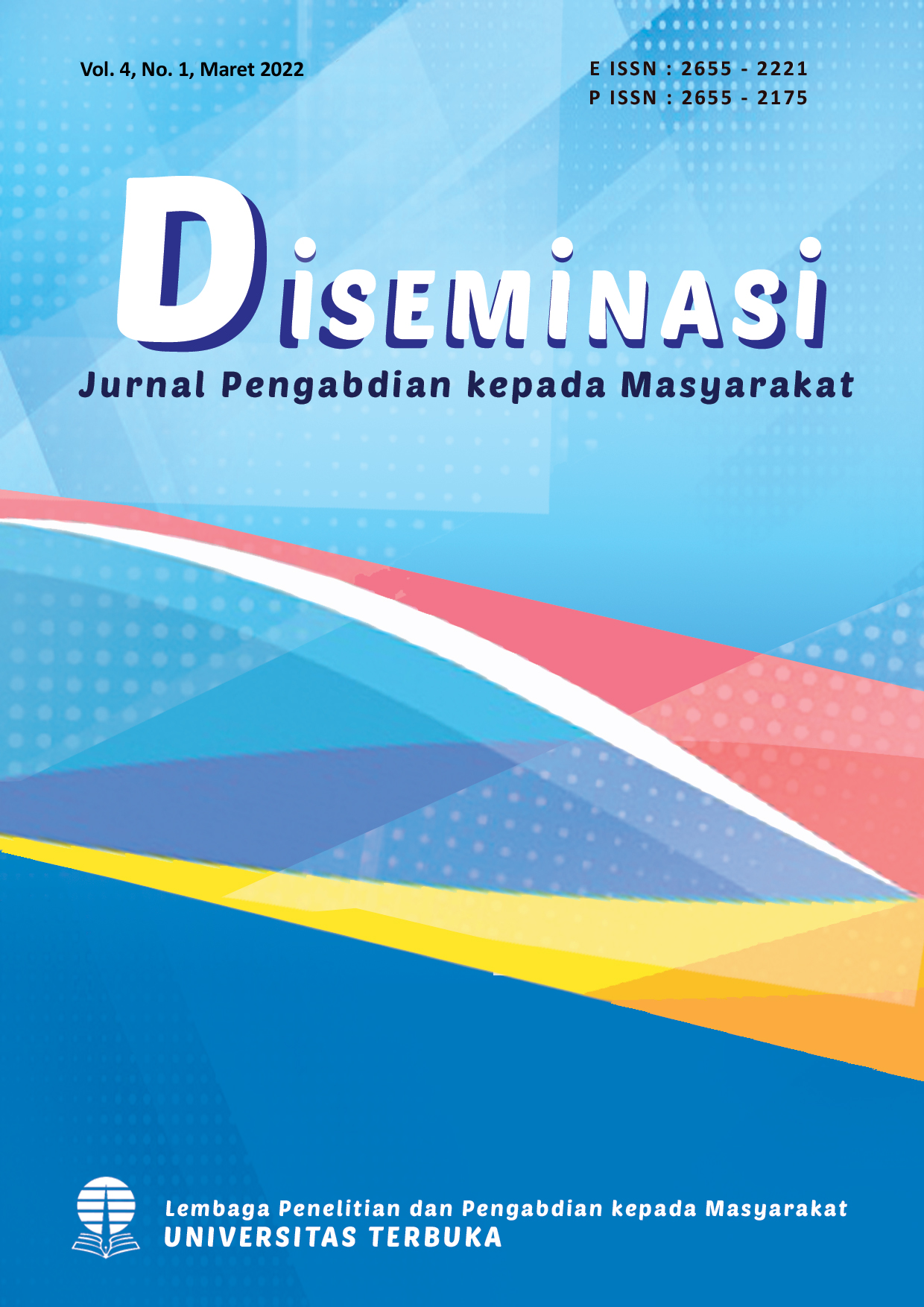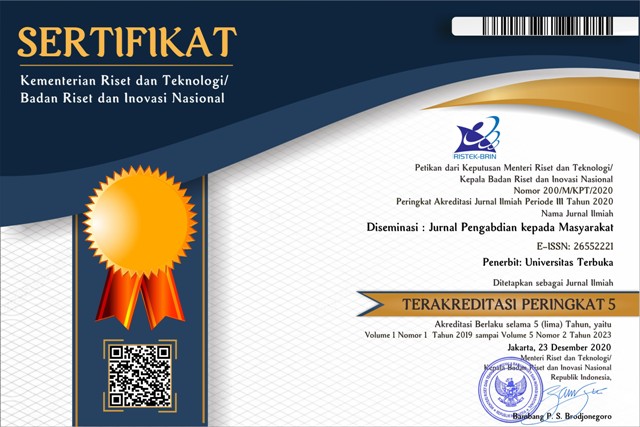CAPACITY BUILDING PRINSIP SAFETY DALAM PENGGUNAAN PESTISIDA PADA PETANI DENGAN MEDIA BUKU SAKU DAN ANIMASI
DOI:
https://doi.org/10.33830/diseminasiabdimas.v4i1.2965Keywords:
health promotion, keselamatan kerja, KWT, promosi kesehatan, peasant women's group, pesticide, pestisida, work safetyAbstract
Pesticides play an important role in agricultural pest control. However, unsafe behavior in pesticide use can lead to a decline in the health of farmers. The principle of occupational safety and health when using pesticides must be carried out by farmers. The purpose of this devotion is capacity building of safety principles in the use of pesticides with pocketbook & animation media. The method used is the CO (Community Organizer) approach with KWT cadres (Peasant Women's Group), Tamantirto Village, Bantul, Yogyakarta through workshop training, discussions, consulting services, face-to-face, Q&A, and mentoring. The result of this capacity building is education and health promotion using the nine principles of safety and animated educational videos. The selection of both media is intended that farmers can easily understand the principles of safety when going to and after using pesticides. In addition, both media are delivered in easy-to-understand language and animations that illustrate the principle of safety with pesticides. Based on the results at the time of the implementation of devotion and evaluation it was concluded that the capacity building activities of the participants were facilitated to understand with their pocketbooks and animations that can be accessed through youtube channels.
Pestisida memegang peranan penting dalam pengendalian hama pertanian. Namun, perilaku tidak aman dalam penggunaan pestisida dapat menyebabkan penurunan derajat kesehatan petani. Prinsip keselamatan dan kesehatan kerja saat menggunakan pestisida harus dilakukan oleh petani. Tujuan pengabdian ini ialah capacity building prinsip-prinsip safety dalam penggunaan pestisida dengan media buku saku & animasi. Metode yang digunakan adalah pendekatan CO (Community Organizer) dengan kader KWT (Kelompok Wanita Tani), Desa Tamantirto, Bantul, Yogyakarta melalui pelatihan workshop, diskusi, layanan konsultasi, tatap muka, tanya jawab, dan pendampingan. Hasil dari capacity building ini adalah edukasi dan promosi kesehatan dengan menggunakan media buku saku Sembilan Prinsip Keselamatan dan video edukasi animasi. Pemilihan kedua media dimaksudkan bahwa petani dapat mudah dalam memahami prinsip-prinsip safety saat akan dan sesudah menggunakan pestisida. Selain itu, kedua media disampaikan dengan bahasa yang mudah dimengerti dan animasi yang mengilustrasikan prinsip safety dengan pestisida. Berdasarkan hasil pada saat pelaksanaan pengabdian dan evaluasi disimpulkan bahwa kegiatan capacity building para peserta dimudahkan untuk memahami dengan buku sakunya dan animasi yang dapat diakses melalui channel youtube.
References
Afshari, M., Poorolajal, J., Assari, M. J., Rezapur-Shahkolai, F., & Karimi-Shahanjarini, A. (2018). Acute pesticide poisoning and related factors among farmers in rural Western Iran. Toxicology and Industrial Health, 1–14. https://doi.org/10.1177/0748233718795732.
Berni, I., Menouni, A., Ghazi, I. El, Duca, R., Kestemont, M., Godderis, L., & Jaafari, S. El. (2020). Understanding farmers’ safety behavior regarding pesticide use in Morocco. Sustainable Production and Consumption. https://doi.org/10.1016/j.spc.2020.11.019.
Darusman, W. W. & T. (2001). Pengalaman Belajar Praktek Pengorganisasian Masyarakat Di Simpul Belajar. Bogor: Yayasan Putera.
Hashemi, S. M., Rostami, R., Hashemi, M. K., & Damalas, C. A. (2012). Pesticide Use and Risk Perceptions among Farmers in Southwest Iran. Human and Ecological Risk Assessment, 18(January), 456–270. https://doi.org/10.1080/10807039.2012.652472.
Houbraken, M., Bauweraerts, I., Fevery, D., Labeke, M. Van, & Spanoghe, P. (2016). Pesticide knowledge and practice among horticultural workers in the Lâm Äồng region. Vietnam: A case study of chrysanthemum and strawberries. Science of the Total Environment, 550, 1001–1009. https://doi.org/10.1016/j.scitotenv.2016.01.183.
Islam, M. N., Bint-E-Naser, S. F., & Khan, M. S. (2017). Pesticide Food Laws and Regulations. Springer International Publishing AG 2017, 37–51. https://doi.org/10.1007/978-3-319-52683-6.
Karunamoorthi, K., Mohammed, M., & Wassie, F. (2012). Knowledge and Practices of Farmers With Reference to Pesticide Management : Implications on Human Health. Archives of Environmental & Occupational Health, 67(October 2014), 109–116. https://doi.org/10.1080/ 19338244.2011.598891.
Kusworo, N. A., Ahwan, Z., Mashuri, M., & Hasyim, M. (2018). Penguatan Peran Faith Based Organizations (FBO) dalam Pencegahan dan Penanggulangan HIV dan AIDS melalui Peran Aktif Young Relegious Leader di Tretes Prigen Pasuruan. Engagement Jurnal Pengabdian Kepada Masyarkat, 2(2), 137–153.
Livingston, G., Hack, L., Steinmann, K. P., Cardwell, E. E. G., & Rosenheim, J. A. (2018). An Ecoinformatics Approach to Field-Scale Evaluation of Insecticide Effects in California Citrus : Are Citrus Thrips and Citrus Red Mite Induced Pests? Journal of Economic Entomology, (April), 1–8. https://doi.org/10.1093/jee/toy067.
Sharif, M., Abdollahzadeh, G., Damalas, C. A., Rezaei, R., & Ahmadyouse, M. (2019). Determinants of pesticide safety behavior among Iranian rice farmers. Science of the Total Environment, 651, 2953–2960. https://doi.org/10.1016/j.scitotenv.2018.10.179.
Sharifzadeh, M. S., Abdollahzadeh, G., Damalas, C. A., & Rezaei, R. (2018). Farmers ’ Criteria for Pesticide Selection and Use in the Pest Control Process. Agriculture, 24(8), 1–16. https://doi.org/10.3390/agriculture8020024.
Sharifzadeh, M. S., Damalas, C. A., & Abdollahzadeh, G. (2017). Perceived usefulness of personal protective equipment in pesticide use predicts farmers ’ willingness to use it. Science of the Total Environment, 609, 517–523. https://doi.org/10.1016/j.scitotenv.2017.07.125.
Downloads
Published
Issue
Section
License
Copyright and Licensing

Diseminasi : Jurnal Pengabdian kepada Masyarakat is licensed under a Creative Commons Attribution-NonCommercial-NoDerivativeWorks 4.0 International License. Allows users to copy and distribute the Article, provided this is not done for commercial purposes and further does not permit distribution of the Article if it is changed or edited in any way, and provided the user gives appropriate credit (with a link to the formal publication through the relevant DOI), provides a link to the license, and that the licensor is not represented as endorsing the use made of the work.















